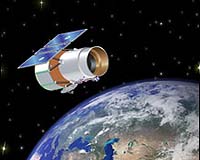 |
Boston MA (SPX) Dec 02, 2009 A recent NASA/ESA Hubble Space Telescope image of part of NGC 7023, or the Iris Nebula, highlights a perfect dust laboratory in the sky. On Earth, we tend to find dust nothing more than a nuisance that blankets our furniture and causes us to sneeze. Cosmic dust can also be a hindrance to astronomers because cameras using visible light cannot see through it. However, studying cosmic dust in detail helps astronomers to pin down the ingredients of the raw mixture that eventually gives birth to stars. This close-up of an area in the northwest region of the large Iris Nebula seems to be clogged with cosmic dust. With bright light from the nearby star HD 200775 illuminating it from above, the dust resembles thick mounds of billowing cotton. It is actually made up of tiny particles of solid matter, with sizes from ten to a hundred times smaller than those of the dust grains we find at home. Both background and foreground stars are dotted throughout the image. NGC 7023 is a reflection nebula, which means it scatters light from a massive nearby star, in this case, HD 200775. Reflection nebulae are different from emission nebulae, which are clouds of gas that are hot enough to emit light themselves. Reflection nebulae tend to appear blue because of the way light scatters, but parts of the Iris Nebula appear unusually red. Researchers studying the object are particularly interested in the region to the left and slightly above centre in the image, where they find dusty filaments to be redder than expected. An unknown chemical compound, most likely based on hydrocarbons, is responsible for the red tinge. The high resolution and sensitivity of Hubble's instruments allow astronomers to study the area in detail. Images and spectra are only part of the analysis. On Earth, scientists are performing additional laboratory tests to assess better the exact chemical composition of the nebula. NGC 7023 was discovered by Sir William Herschel in 1794; the nebula is in the constellation of Cepheus, the King, in the northern sky. NGC 7023 is approximately 1400 light-years from Earth and about six light-years across. This aethereal image was taken by Hubble's Advanced Camera for Surveys. Astronomers also used Hubble's Near Infrared Camera and Multi-Object Spectrometer (NICMOS) instrument to try to determine which chemical elements are present in the nebula. Share This Article With Planet Earth
Related Links Hubble Space Telescope Astronomy News from Skynightly.com
 Wide-field Infrared Survey Explorer Ready For Launch On December 9
Wide-field Infrared Survey Explorer Ready For Launch On December 9Pasadena CA (SPX) Nov 26, 2009 The launch of NASA's Wide-field Infrared Survey Explorer, or WISE, aboard a United Launch Alliance Delta II rocket is scheduled for Wednesday, Dec. 9. Liftoff will be from NASA's Space Launch Complex 2 at Vandenberg Air Force Base in California. The launch window is approximately 14 minutes in duration, extending from 6:09:33 to 6:23:51 a.m. PST (9:09:33 to 9:23:51 a.m. EST). ... read more |
|
| The content herein, unless otherwise known to be public domain, are Copyright 1995-2009 - SpaceDaily. AFP and UPI Wire Stories are copyright Agence France-Presse and United Press International. ESA Portal Reports are copyright European Space Agency. All NASA sourced material is public domain. Additional copyrights may apply in whole or part to other bona fide parties. Advertising does not imply endorsement,agreement or approval of any opinions, statements or information provided by SpaceDaily on any Web page published or hosted by SpaceDaily. Privacy Statement |